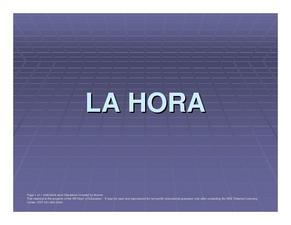Curated OER
La Hora
Present this to your beginning Spanish scholars to teach them how to tell time in the target language. The first three slides offer examples to try together, and then there are several opportunities for learners to practice either as a...
Curated OER
Direct Object Pronouns
What is a direct object pronoun and how do you use one? After looking at several examples, give your Spanish speakers an opportunity to practice. Can they place the direct object pronoun correctly in the sentence provided? Two separate...
Curated OER
ASL: Building a functional vocabulary
Best resource ever! Teaching and learning to teach ASL just got easier. For special education teachers or those working with hearing impaired students, this instructional activity provides story and time telling practice using ASL. Each...
Curated OER
¡Cha cha en Chihuahua!
Can you name all of the Mexican states? Most Americans can't, even though Mexico is our close neighbor. Encourage your Spanish learners to research a Mexican state and create a comprehensive PowerPoint to share the newly acquired...
Curated OER
Reflexive Verbs
A verb is reflexive when the subject and the object are the same. After introducing your intermediate Spanish speakers to some of the most common reflexive verbs, assign them this sheet for practice. First, they write the reflexive...
Curated OER
Present Progressive Tense
Practice the present progressive tense with three different exercises. In the first, simply take the infinitive and put it in the present progressive tense. Next, correctly conjugate the verb in parentheses so that the sentence makes...
Curated OER
Que hora es? What time is it?
How is telling time in Spanish different from telling time in English? This reference guide doesn't provide any practice opportunities, but it has clear, bulleted information, and several examples are provided. Reinforce the information...
Curated OER
Tener Phrases Illustrated
When do you use the verb tener? There are twelve expressions listed, each accompanied by an illustration. Since words and phrases are better remembered with visual images, provide this sheet for your learners to memorize.
Curated OER
Spanish Sentence Construction
After reviewing Spanish articles, nouns, noun gender, subject pronouns, and the verb ser, give your emerging Spanish speakers this practice packet. Several activities are included: an unscrambling exercise, translation practice, an...
Curated OER
La Rana Azul
Who is Blaney? Why is she different from other frogs? Read the passage with your emergent readers, and answer the comprehension questions that follow. Consider reviewing the questions with your learners before they read the text, and...
Curated OER
Ir+a+the Infinitive Form of the Verb
With the ir verb, meaning to go, Spanish speakers can also say "I am going to..." Complete two quick exercises to show them the different use ir can have.
Curated OER
-Er/-Ir Verb Table
Conjugate basic Spanish verbs with this organized table. Common ir and er verbs are covered (ver, correr, aprender, vivir, etc.). Provide this for your learners to review verb conjugations before an upcoming test.
Curated OER
Communicative Activity: Conversations
After teaching your emergent Spanish speakers basic greetings, questions, and dates, have them practice their vocabulary aloud! Each learner will be responsible for talking to ten different classmates, recording their birthday from each....
Curated OER
Spanish Numbers Coloring Packet
A perfect packet of exercises for your young Spanish learners! They'll practice counting, spelling, and printing numbers! Sweet illustrations make this packet fun!
Curated OER
Irregular Formal Commands (Mandatos)
How do you form irregular formal commands in Spanish? Now that your class has learned how to form the Ud. and Uds. commands, review some of the irregular formal commands. First encourage learners to study the charts at the top of the...
Curated OER
La Fecha
How are dates written in Spanish? Learn the differences between writing dates in English and Spanish. Then, after studying the explanation and examples, practice changing dates written in English into Spanish dates.
Curated OER
El Verbo ir- Explanation and Practice 1
The Spanish verb ir, meaning to go, is an important verb for your language learners to understand. Use the chart to help clarify its meaning and conjugation, then encourage your Spanish speakers to complete the fill-in-the-blank section...
Curated OER
Understanding Questions in Spanish
How can you discover what a question is asking in Spanish? Use this scaffolded worksheet to help your learners understand how questions are formed in Spanish.
Curated OER
Verbos con cambios radicales
Stem-changing, or radical changing, verbs are fairly common in Spanish. Provide your Spanish class with this reference guide to discuss the stem changes that occurs in the yo, tú, él, ella Ud., ellos, ellas, and Uds. forms.
Curated OER
Comparativos y superlativos
What are comparative and superlative adjectives? This reference guide provides a great explanation and several examples of each in both English and Spanish. Encourage your Spanish speakers to hang onto this resource!
Curated OER
Practica: Subjunctive in Relative Clauses
If your Spanish speakers have already been introduced to the subjunctive, this is the perfect follow-up learning exercise. Two exercises focus on altering Spanish sentences to use either the indicative or the subjunctive form. A great...
Curated OER
The Gender Nouns
What a fun way to review noun gender! This activity is complex, but it will surely engage your learners. Beginning Spanish speakers determine the definite article for a list of nouns and color in the square grid provided. What famous...
Curated OER
Present Tense of -ar verbs Worksheet 4
Use the English sentences to practice your Spanish translating skills. The worksheet is divided into categories: yo, tú, usted, nosotros, and ustedes, so you can practice conjugating the selected -ar verb in all subject forms.
Curated OER
Basic Verb Conjugations
Getting ready to review basic conjugations for a present tense verb test? Easy conjugation charts are provided for hacer, querer, venir, estar, andar, tener, poder, poner, and saber. Perfect test review!

























